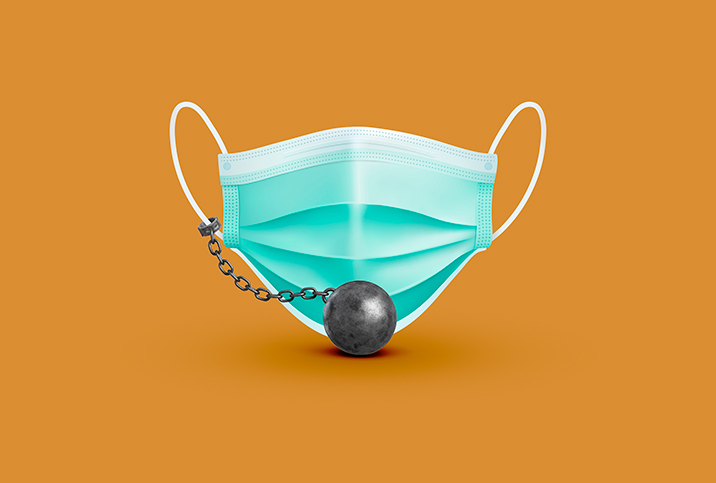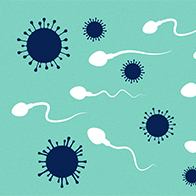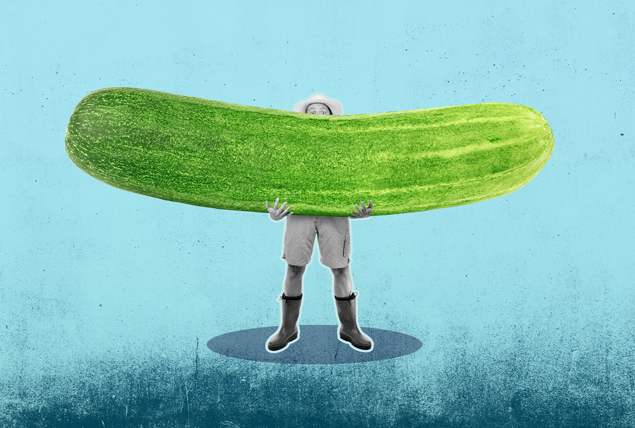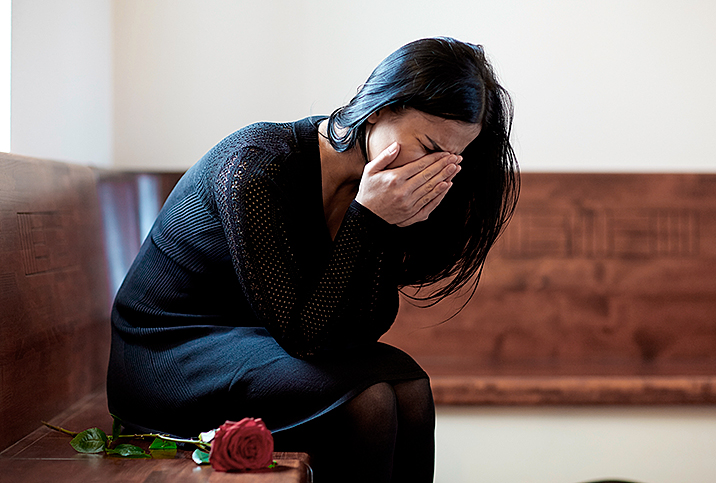COVID-19: Where Are We Now?

Before we know it, COVID-19 will have its two-year anniversary. Masks are now an integral part of life, disinfectants are still required purchases and more people than ever are working or going to school remotely.
Though different parts of the world are seeing different patterns, we will likely feel the pandemic's aftershocks for years to come—we're not out of the woods yet.
Checking in on the statistics
Though vaccine implementation this year has made a big dent, the U.S. still reports a significant number of cases. By the time you read this, there will have been 50 million cases and about 800,000 deaths, according to the Centers for Disease Control and Prevention (CDC). The bright spot is that roughly 500 million doses of the vaccine have been distributed, and more than 200 million Americans are fully vaccinated, which represents more than 60 percent of the population.
On a global level, the World Health Organization (WHO) estimates more than 250 million confirmed cases, more than 5 million deaths and more than 7 billion vaccine doses administered.
Based on the numbers, America is leading the pack.
"The most available numbers out there are going to be cases and deaths, but it's important to scale any of the numbers by the actual population," said David Dowdy, M.D., Ph.D., ScM, an associate professor of epidemiology at Johns Hopkins University. "Big countries are going to have big numbers because there are a lot of people."
Dowdy said if the question is more about transmission, you would want to look at cases, but if you're thinking about the burden of the disease, it makes more sense to look at deaths or hospitalizations.
"In places like the U.S., right now cases are going up and deaths are going down—that's not necessarily a bad thing," Dowdy added. "It could be argued that we would be more worried about severe cases, not overall cases."
As compared to Oz
The WHO surmises the case count, hospitalization and death rates would be far lower if more regions would be as proactive as countries like Australia.
Alex Polyakov, a senior lecturer at the University of Melbourne, Australia, who has expertise in multiple disciplines including a master's in clinical epidemiology, provided firsthand knowledge of the stark contrast in other parts of the world.
"I think that in Australia, we are certainly under control—we have at least 80 percent of the population over 12 [years old] double-vaccinated and are expected to reach more than 90 percent coverage in the next months, so the number of cases is manageable and really quite small," Polyakov reported.
To put these numbers into perspective, he noted that of Australia's 25 million citizens, the total mortality rate was only about 2,000 people over the past two years. Currently, per million people, the U.S. has a mortality rate 32 times higher than Australia.
"[In the U.S.], kids are more likely to get infected these days, so case numbers are higher, but in terms of people who get really sick, those are the people who are old or immunocompromised," Dowdy said. "So, there are conditions that make people more likely to be infected, and conditions that make people more likely to get really sick."
Currently, per million people, the U.S. has a mortality rate 32 times higher than Australia.
In contrast, Australia doesn't plan on offering childhood vaccinations because childhood illness rates are so low.
Scientists are now concerned with a foreseen jump in cases. Like the flu, COVID-19 transmission is expected to rise during the winter months in the States. What was once a gradual reduction in incidence is now changing course, hypothesized to be because of a combination of waning vaccine-derived immunity, pandemic fatigue and behavioral relaxation. While the U.S. continuously experiences fluctuating mandates, the whole of Australia was essentially shut down for more than a year.
"You've got to distinguish two situations," Polyakov explained. "When vaccines are available and the population is hesitant to take it—which is certainly the case in the U.S. and certain parts of Europe—and then there are other countries where vaccines are simply not available enough, like third-world countries."
He claims Australia fared so well because of widespread vaccine access and strict government mandates.
"The population was motivated to be vaccinated because the government essentially said that if you're not vaccinated, your life is over," Polyakov added. "People wanted to go back to normal, so people went to get vaccinated even if they didn't want to."
Repercussions
Death from COVID-19 is obviously the worst-case scenario, but we would be remiss not to acknowledge the effect the pandemic has caused in all aspects of life. Collective anxiety has swept the globe, and political, social and economic divides have widened. We're all feeling the exhaustion and frustration stemming from the pandemic.
One of the largest areas impacted has been the healthcare system—its very infrastructure has been shaken. However, a benefit has been the primarily successful incorporation of telehealth, allowing organizations to track pandemic epidemiology in real time while still remaining distanced.
"Clearly this has taken a huge toll on our healthcare system in terms of provider burnout and resources," Dowdy said. "If you're in a crowded hospital, you're not going to get the same level of care as if you are the only patient people have to take care of. We've seen surges where hospitals are reaching capacity, where mortality rates go up because people are sicker."
Clearly, our healthcare system is not perfect—for several reasons, including that there are simply not enough behavioral and mental health resources to support people suffering from the mental illness and substance abuse that has skyrocketed since COVID-19 began.
"I think that this will be something that people carry with them for their lives," Dowdy explained. "It's hard to tell the long-term impact of this on our individual and collective mental health, and how we're going to function together."
Polyakov added, "There will be a lot of research done on the effect of lockdowns on mental health, and I'm sure it will not be all positive."
Additionally, it's impossible to ignore the inequalities in care for certain demographics, especially minorities.
"[Minorities] have lower access to healthcare due to systemic problems within our healthcare system," Dowdy said. "This is partially because they have larger numbers of people who can't avoid situations where they might be at risk of getting it."
He asserted our need to prioritize vaccinating individuals unable to avoid exposure.
Will it ever end-emic?
Despite how it seems if you're following daily news reports, COVID-19 is expected to eventually become endemic. This doesn't mean the virus will be completely gone, but rather that we will gain enough immunity from natural infection and vaccines to significantly reduce symptoms.
"We are at a very high level of immunity in the population, so it's possible we're getting close to what things are going to look like for a while," Dowdy explained. "The future of this pandemic is still a little uncertain, but we probably have seen the worst of it. But this is not something that's gonna be going away anytime soon, either. I think that at the end of the day, what is needed is a collective effort by all members of society. We really have to come together to fight this virus."
Places like Australia can already see the light at the end of the tunnel, where things have essentially returned to normal and there are minimal, if any, restrictions.
"We're in a situation where it is now endemic—it's going to be around for a long time and it's not likely to go away," Polyakov said. "What I think will happen is that eventually there will be annual vaccination for COVID and that we'll keep it at bay."
His primary concern for the future is that it could turn out like the seasonal flu, with a different variant every year, though he believes vaccinations will be the key to endemicity.
The timeline is unknown and dependent on global responses: Everyone must take proper precautions for it to become endemic. If the past two years have shown us anything, it's that we must come together as a global society to wrangle COVID-19 under control.
COVID-19: Where Are We Now?

Before we know it, COVID-19 will have its two-year anniversary. Masks are now an integral part of life, disinfectants are still required purchases and more people than ever are working or going to school remotely.
Though different parts of the world are seeing different patterns, we will likely feel the pandemic's aftershocks for years to come—we're not out of the woods yet.
Checking in on the statistics
Though vaccine implementation this year has made a big dent, the U.S. still reports a significant number of cases. By the time you read this, there will have been 50 million cases and about 800,000 deaths, according to the Centers for Disease Control and Prevention (CDC). The bright spot is that roughly 500 million doses of the vaccine have been distributed, and more than 200 million Americans are fully vaccinated, which represents more than 60 percent of the population.
On a global level, the World Health Organization (WHO) estimates more than 250 million confirmed cases, more than 5 million deaths and more than 7 billion vaccine doses administered.
Based on the numbers, America is leading the pack.
"The most available numbers out there are going to be cases and deaths, but it's important to scale any of the numbers by the actual population," said David Dowdy, M.D., Ph.D., ScM, an associate professor of epidemiology at Johns Hopkins University. "Big countries are going to have big numbers because there are a lot of people."
Dowdy said if the question is more about transmission, you would want to look at cases, but if you're thinking about the burden of the disease, it makes more sense to look at deaths or hospitalizations.
"In places like the U.S., right now cases are going up and deaths are going down—that's not necessarily a bad thing," Dowdy added. "It could be argued that we would be more worried about severe cases, not overall cases."
As compared to Oz
The WHO surmises the case count, hospitalization and death rates would be far lower if more regions would be as proactive as countries like Australia.
Alex Polyakov, a senior lecturer at the University of Melbourne, Australia, who has expertise in multiple disciplines including a master's in clinical epidemiology, provided firsthand knowledge of the stark contrast in other parts of the world.
"I think that in Australia, we are certainly under control—we have at least 80 percent of the population over 12 [years old] double-vaccinated and are expected to reach more than 90 percent coverage in the next months, so the number of cases is manageable and really quite small," Polyakov reported.
To put these numbers into perspective, he noted that of Australia's 25 million citizens, the total mortality rate was only about 2,000 people over the past two years. Currently, per million people, the U.S. has a mortality rate 32 times higher than Australia.
"[In the U.S.], kids are more likely to get infected these days, so case numbers are higher, but in terms of people who get really sick, those are the people who are old or immunocompromised," Dowdy said. "So, there are conditions that make people more likely to be infected, and conditions that make people more likely to get really sick."
Currently, per million people, the U.S. has a mortality rate 32 times higher than Australia.
In contrast, Australia doesn't plan on offering childhood vaccinations because childhood illness rates are so low.
Scientists are now concerned with a foreseen jump in cases. Like the flu, COVID-19 transmission is expected to rise during the winter months in the States. What was once a gradual reduction in incidence is now changing course, hypothesized to be because of a combination of waning vaccine-derived immunity, pandemic fatigue and behavioral relaxation. While the U.S. continuously experiences fluctuating mandates, the whole of Australia was essentially shut down for more than a year.
"You've got to distinguish two situations," Polyakov explained. "When vaccines are available and the population is hesitant to take it—which is certainly the case in the U.S. and certain parts of Europe—and then there are other countries where vaccines are simply not available enough, like third-world countries."
He claims Australia fared so well because of widespread vaccine access and strict government mandates.
"The population was motivated to be vaccinated because the government essentially said that if you're not vaccinated, your life is over," Polyakov added. "People wanted to go back to normal, so people went to get vaccinated even if they didn't want to."
Repercussions
Death from COVID-19 is obviously the worst-case scenario, but we would be remiss not to acknowledge the effect the pandemic has caused in all aspects of life. Collective anxiety has swept the globe, and political, social and economic divides have widened. We're all feeling the exhaustion and frustration stemming from the pandemic.
One of the largest areas impacted has been the healthcare system—its very infrastructure has been shaken. However, a benefit has been the primarily successful incorporation of telehealth, allowing organizations to track pandemic epidemiology in real time while still remaining distanced.
"Clearly this has taken a huge toll on our healthcare system in terms of provider burnout and resources," Dowdy said. "If you're in a crowded hospital, you're not going to get the same level of care as if you are the only patient people have to take care of. We've seen surges where hospitals are reaching capacity, where mortality rates go up because people are sicker."
Clearly, our healthcare system is not perfect—for several reasons, including that there are simply not enough behavioral and mental health resources to support people suffering from the mental illness and substance abuse that has skyrocketed since COVID-19 began.
"I think that this will be something that people carry with them for their lives," Dowdy explained. "It's hard to tell the long-term impact of this on our individual and collective mental health, and how we're going to function together."
Polyakov added, "There will be a lot of research done on the effect of lockdowns on mental health, and I'm sure it will not be all positive."
Additionally, it's impossible to ignore the inequalities in care for certain demographics, especially minorities.
"[Minorities] have lower access to healthcare due to systemic problems within our healthcare system," Dowdy said. "This is partially because they have larger numbers of people who can't avoid situations where they might be at risk of getting it."
He asserted our need to prioritize vaccinating individuals unable to avoid exposure.
Will it ever end-emic?
Despite how it seems if you're following daily news reports, COVID-19 is expected to eventually become endemic. This doesn't mean the virus will be completely gone, but rather that we will gain enough immunity from natural infection and vaccines to significantly reduce symptoms.
"We are at a very high level of immunity in the population, so it's possible we're getting close to what things are going to look like for a while," Dowdy explained. "The future of this pandemic is still a little uncertain, but we probably have seen the worst of it. But this is not something that's gonna be going away anytime soon, either. I think that at the end of the day, what is needed is a collective effort by all members of society. We really have to come together to fight this virus."
Places like Australia can already see the light at the end of the tunnel, where things have essentially returned to normal and there are minimal, if any, restrictions.
"We're in a situation where it is now endemic—it's going to be around for a long time and it's not likely to go away," Polyakov said. "What I think will happen is that eventually there will be annual vaccination for COVID and that we'll keep it at bay."
His primary concern for the future is that it could turn out like the seasonal flu, with a different variant every year, though he believes vaccinations will be the key to endemicity.
The timeline is unknown and dependent on global responses: Everyone must take proper precautions for it to become endemic. If the past two years have shown us anything, it's that we must come together as a global society to wrangle COVID-19 under control.
















